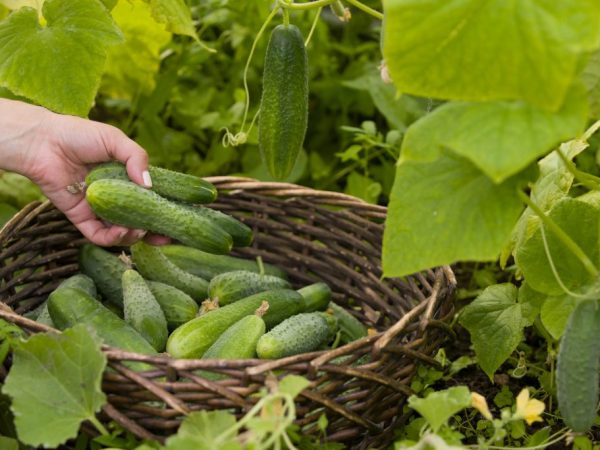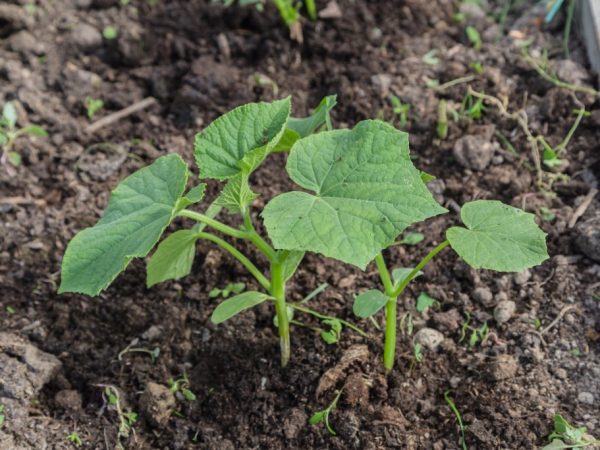How to feed cucumbers in the open field
It is better to plant cucumbers in open ground in May, when the soil has already warmed up enough. Observing the cultivation technology and following the rules of care, you can significantly increase the fruiting period of cucumbers, so all gardeners need to know what should be the feeding of cucumbers in the open field.

Top dressing of cucumbers in the open field
Soil requirements
Top dressing of cucumbers in the open field is carried out depending on the condition of the soil. If the soil on your site is sufficiently fertilized, then you can not apply fertilizing at all or not often. If the soil in the garden is poor, then when transplanting into open ground, you need to fertilize with complex fertilizers.
To prepare a site for planting cucumbers, they begin in the fall - while digging up the soil. In autumn, compost, mullein or humus (humus) are added to the soil at the rate of 5 kg per 1 sq. m.
Instead of organic matter, it is permissible to use minerals rich in nitrogen - urea or ammonium nitrate. Also, fertilizers containing potassium and phosphorus are added to nitrogen fertilizers. For 1 sq. m requires 10-25 g of potassium salt and 15-30 g of superphosphate. Before the very planting of cucumbers, the soil does not need special preparation or fertilization - it is enough to loosen it and form holes and beds. After planting cucumbers in open ground, the plants take time to root and adapt.
This process usually takes 7 to 10 days. Temporary cessation of growth should not be a cause for concern. Later, when the plants adapt, growth will resume. If the plants do not take root, you need to fertilize them with organic matter and minerals. Organic and mineral dressing can be carried out immediately after planting in open ground and plant adaptation. It is not necessary to use ready-made commercial formulations. Good results can be achieved with homemade fertilizers that can be made at home.
Mineral dressing
Mineral fertilizers are easy to use, they can be purchased in stores in the form of ready-made mixtures, or compiled from individual components on your own.
The following composition works well for cucumbers:
- Urea - 20 g
- Superphosphate - 10 g
- Potassium sulfate - 7 g
The components are diluted in 10 liters of water. Water the plants in the evening. Instead of urea, ammonium nitrate in the amount of 7 g is acceptable. In addition, with a solution of 50 g of urea in 10 liters of water, you can feed the cucumbers during the period of fruit setting and growth.
Ready-made mineral complexes are more convenient because they already contain a balanced set of elements. The following preparations are especially effective when growing cucumbers in 2018 - kemira, good power, toppers, zeovit cucumbers and others. It is important to remember that cucumbers must be watered abundantly before feeding. You should also avoid getting fertilizers on plant leaves. If you accidentally fertilize the leaf mass, then you should carefully wash off the solution in order to avoid burning the leaves.
Organic fertilizers
Organic fertilizers have a high nitrogen content, which is required for cucumbers to build up green mass. Organics are environmentally friendly and efficient. Plus, organic fertilizers are easier to find and purchase. Mainly in the villages, organic matter is sold by residents who keep cattle and small ruminants or poultry.
Mullein based

Organic fertilizers are safe
Of all the organic remedies, mullein is the most commonly used. In addition to nitrogen, it contains a lot of additional elements. Fertilization with a mullein is carried out not only during the first feeding of cucumbers immediately after their rooting, but also after.
Preparation
- Manure - 1 kg
- Water - 5 l
You cannot use the solution right away. Due to the active oxidative processes taking place in it, there is a high risk of burning the plants. The mullein should be infused for at least a week - during this time it will ferment and change its color to a lighter one. Such fertilization will already be completely safe. By adding wood ash to the mullein (1 glass per 10 liters of concentrated infusion), you can get a complex fertilizer with a high content of potassium and phosphorus. The feeding procedure is carried out in the evening, watering the plants at the root. Before use, the finished concentrate is dissolved in water: 1 part of mullein to 10 parts of water.
On bird droppings
Poultry manure solutions are effective during the period of ovary formation. Poultry droppings can significantly increase yields, contains even more nitrogen than mullein, and therefore must be infused. Poultry droppings are mixed with water at the rate of 1 part of droppings to 20 parts of water and infused for 1.5-2 weeks. Before feeding, the concentrate is diluted until a yellow-orange color is obtained. It will not be superfluous to add superphosphate to the solution with droppings.
It is also permissible to use dry litter, having previously dried it in the open air. Such a mixture is introduced into the soil at 150 grams per 1 sq. meter. Poultry manure pellets are available at gardening stores. Experts note a number of advantages of such fertilizer over natural: readiness for use, lack of smell, weeds and parasites, ease of transportation.
Herbal fertilizers
An infusion of nettle or weeds gives a good result. You can fertilize with a natural composition 2-3 times per season. Finely chopped grass is poured with water in a ratio of 1: 2 and infused until fermentation stops. If you add ash and mullein, you can create an effective complex blend. It is better to dilute the concentrate with water to a shade of freshly brewed tea before use.
Additional feeding
Foliar application of nutrients is not considered basic and is used only as an addition to the root. Usually they are introduced between the main ones, once every 2 weeks. Spraying should be carried out in calm weather, in the morning or in the evening.
Cucumbers need additional feeding at different periods:
- The cucumber receives everything it needs not only from the soil, but also through the surface of the leaves, so foliar feeding allows you to quickly deliver the necessary nutrients.
- When symptoms of micronutrient deficiency appear. It is imperative to spray the leaves during periods of cold snaps, when the root system of cucumbers ceases to supply nutrients.
- During active growth and green mass gain, fertilizers with nitrogen content are relevant. In this case, 25 g of urea or 20 g of ammonium nitrate are diluted with 10 liters of water.
- During flowering and ripening of fruits, cucumbers especially need potassium and phosphorus. In 10 liters of water, 200 g of superphosphate and 50 g of potassium chloride (or 100 g of potassium sulfate) are diluted. It will also be useful to spray with a solution of copper sulfate at a concentration of 2 g of sulfate per 10 liters of water. This procedure significantly reduces the number of barren flowers on the plant.
Folk recipes

Top dressing will saturate the plants with useful substances
Traditional methods of plant feeding are based on the use of environmentally friendly and affordable means. Folk recipes for the preparation and introduction of nutrient and vitamin components are used by many gardeners.
Top dressing on ash
Ash contains a large amount of potassium, which is necessary for the development of cucumber fruit. It is possible to fertilize with ash throughout the entire growing season of the plant, starting with adding it to the soil when sowing seeds.
The planted plants should be fertilized in the following cases:
- When leaves of the second order appear.
- After the beginning of flowering.
- Every 2 weeks when fruiting.
It is allowed to add ash as a component to other nutrients, or use ash in dry form or in the form of infusion. Dry ash is prepared at the rate of 200 gzols per 10 liters of water. The resulting mixture is infused for several days, after which it is diluted with water in a ratio of 1:10 and poured under the root.
Yeast feeding
Yeast strengthens the root system of cucumbers and stimulates the development of new roots. Many gardeners note that growing cucumbers using yeast fertilizers has a positive effect on planting, fruiting becomes more active. The vitamins and minerals contained in yeast have a beneficial effect on the plant as a whole, and bacteria that feed on yeast saturate the soil with oxygen. Caring for plants with proper feeding with yeast is noticeably simplified.
To prepare a yeast mixture you will need:
- Dry yeast - 10 g
- Sugar - 2 tbsp. l
Yeast and sugar should be dissolved in 10 liters of heated water and left to ferment in a warm place. After a few hours, the yeast infusion is mixed with another 50 liters of water. The prepared mixture can be used in combination with other nutrients.
You need to feed cucumbers with a yeast mixture no more than 3 times during the entire life of the plant. In order for fungi and bacteria living in the soil to be most active, feeding should be carried out only in warm periods, when the soil is completely warmed up.
Top dressing on honey
In cold, rainy years, the crop yield decreases. Foliar application of honey solution will help to support it. To prepare a honey solution, dissolve a tablespoon of honey in 1 liter of hot water. The cooled solution is sprayed with leaves and flowers of cucumbers. The honey scent attracts insects, so the plants are pollinated more actively.
Conclusion
Before planting cucumbers in open ground, you should take care not only of preparing the land. Timely introduction of nutrients and proper care is the main condition for obtaining a bountiful harvest. Competently organized top dressing allows you to grow a bountiful harvest.


